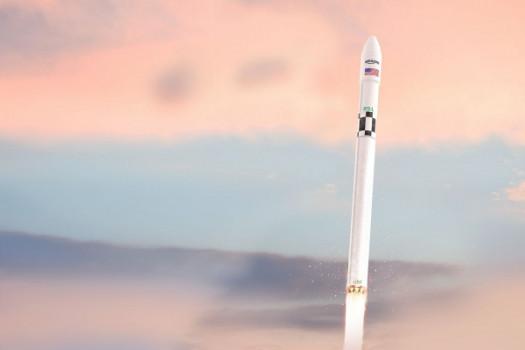
The company wants to launch them on a new rocket from ABL Space Systems

Amazon’s ambitious satellite-internet project, Project Kuiper, aims to launch its first two prototype satellites in the fourth quarter of 2022, according to an experimental launch license the company filed with the Federal Communications Commission today. Called KuiperSat-1 and KuiperSat-2, the two prototypes are supposed to launch on an experimental new rocket called the RS1, currently being developed by startup ABL Space Systems based in El Segundo, California.
Kuiper’s goal is to launch a giant constellation of up to 3,236 satellites into low Earth orbit over the next decade in order to provide low-latency broadband internet coverage to the surface below. The plan is to serve rural communities and other areas where it’s difficult to provide infrastructure for traditional internet services. It’s a similar concept to that of Starlink, SpaceX’s broadband internet satellite constellation, which proposes sending nearly 12,000 into low orbit around Earth. But unlike Kuiper, Spacex has actually launched more than 1,700 of its satellites and even created a beta program for hundreds of users. Kuiper has yet to launch any satellites.
the Amazon subsidiary seems almost ready to get started
Now, the Amazon subsidiary seems almost ready to get started. Last week, the company showed off testing of the thrusters the satellites will use to maneuver through space. And Kuiper claims that these first prototypes will allow the company to test out the same “communication and networking technology” that will be included in the finalized satellites. The two prototypes will operate at 366 miles, or 590 kilometers, above Earth. KuiperSat-1 and KuiperSat-2 will house plenty of the same technology needed for the final constellation, including antennas, modems, and power and propulsion.

While in space, the satellites will be used to test out their ability to connect with four of Kuiper’s user terminals and a ground station in McCulloch, Texas, designed to send and receive broadband signals from the spacecraft. The entire test sequence is set to last just 10 minutes as each satellite passes overhead.
“There is no substitute for on-orbit testing, and we expect to learn a lot given the complexity and risk of operating in such a challenging environment,” Rajeev Badyal, vice president of technology for Project Kuiper, said in a statement. “We can’t wait to get started.” So far, Kuiper says it has done some testing on the ground with its user terminals, claiming to get maximum throughput speeds of up to 400 Mbps. Starlink’s beta program touts download speeds up to 100 Mbps and 200 Mbps.
Kuiper’s choice to fly its first two prototypes on ABL’s RS1 rocket is an unexpected one
Kuiper’s choice to fly its first two prototypes on ABL’s RS1 rocket is an unexpected one. In April, the company announced that it had purchased nine flights of the United Launch Alliance’s workhorse Atlas V rocket in order to launch batches of Kuiper satellites. Meanwhile, ABL has yet to actually launch one of its rockets. The company says it’s aiming to conduct its first test launch with the RS1 before the end of the year out of Alaska. Kuiper says it’s been “impressed by ABL’s unique capabilities, rapid development progress, and dedication to customers,” according to a blog post published today. ABL’s RS1 rocket will have the capability to launch roughly 1.5 tons of payload to low Earth orbit at approximately $12 million per flight, which Kuiper claims is the “right capacity and cost-efficiency to support our mission profile.” An Amazon spokesperson confirmed that the smaller RS1 is more appropriate for the launch of two satellites, while Kuiper plans to use the Atlas V rockets to deploy the full constellation.
Along with today’s news, Kuiper is also trying to reassure the space community that the company will attempt to mitigate any harmful effects of its satellites. One big criticism of proposed mega-constellations like Kuiper and Starlink is that they will lead to a much more crowded environment in low Earth orbit, increasing the likelihood of in-space collisions and making it more difficult to launch satellites in the future. Kuiper says it will take its prototype satellites out of orbit when it’s done testing them by plunging them into Earth’s atmosphere, where they’ll burn up.
Kuiper also says it’s been “working with astronomers and others in the industry to reduce the visibility of Kuiper System satellites.” Astronomers have raised concerns about the rise of satellite mega-constellations, as the influx of bright satellites will lead to more disruption of observations of the night sky. To help dampen the brightness of its satellites, Kuiper is including a sunshade on one of the two prototypes to lessen its ability to reflect light from the Sun. “We will collect data to compare reflectivity between the two spacecraft and share any learnings with the astronomy community following the mission,” Kuiper wrote in its blog post. SpaceX has also launched more than 1,000 of its satellites with sunshades, or visors, to dampen their brightness.
This latest announcement from Kuiper comes a week after the company announced a partnership with Verizon to expand the carrier’s 4G / LTE and 5G coverage to more underserved areas. Such a deal relies on Kuiper launching its satellites first.








